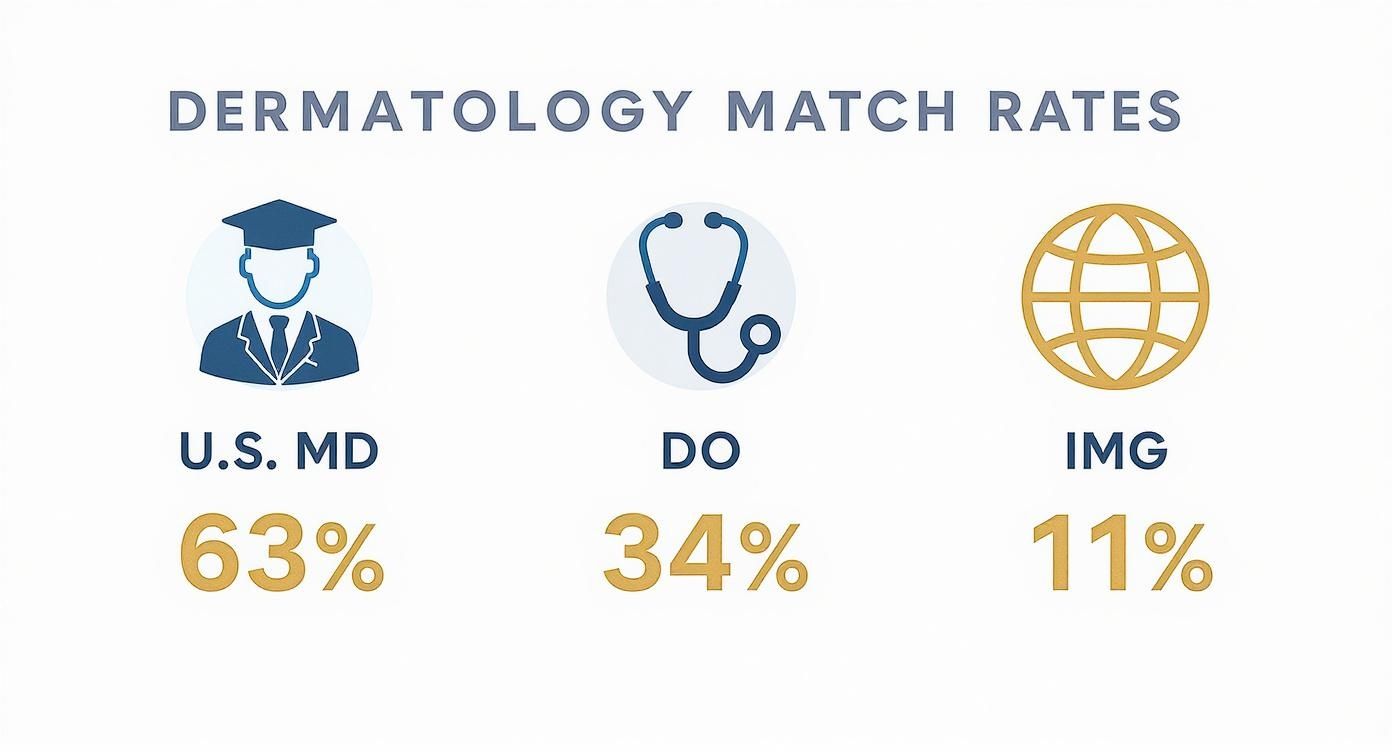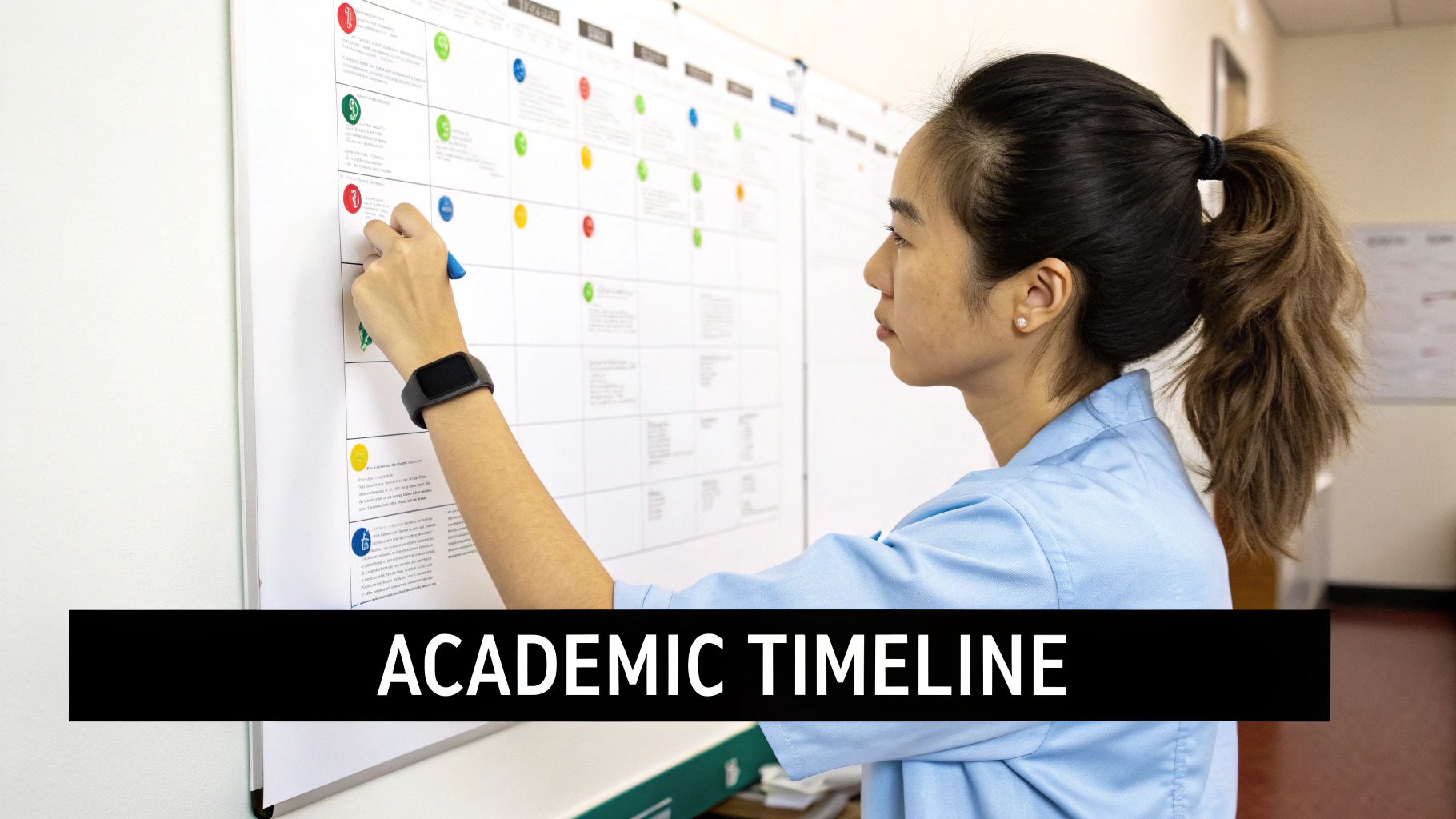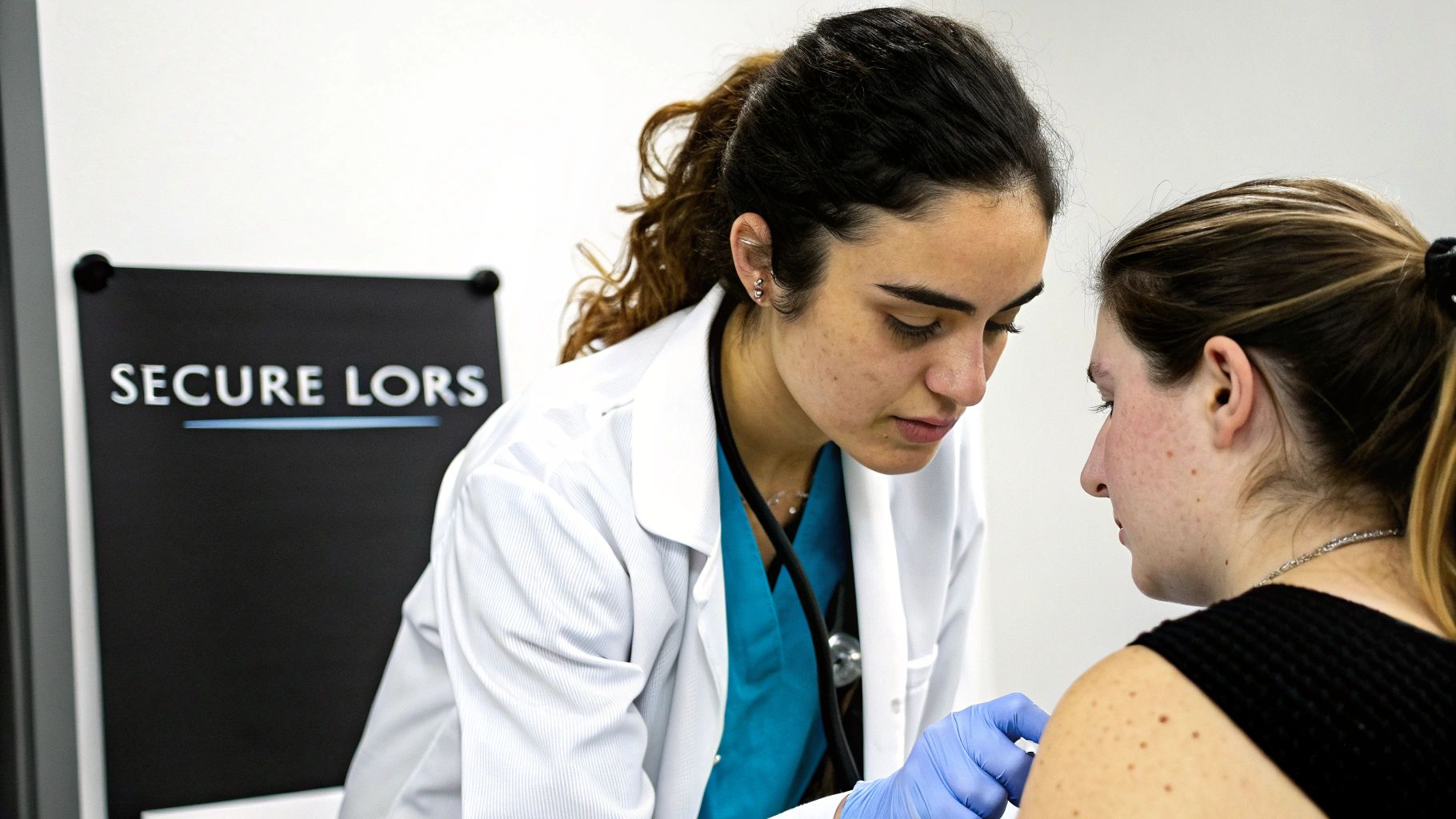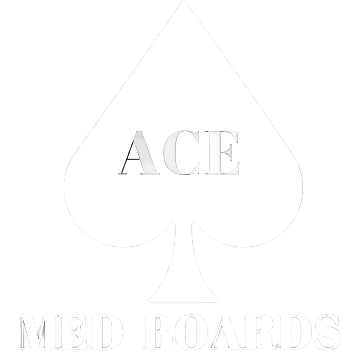Matching into dermatology isn't a sprint; it's a marathon you start training for the moment you step into medical school. It demands top-tier academic performance, a seriously impressive research portfolio, and sharp clinical skills. Success really comes down to a multi-year strategy focused on crushing your board exams, publishing meaningful research, and shining on your away rotations.
Understanding the Dermatology Match Landscape
Before you can build a winning game plan, you need to understand why dermatology is one of the most competitive specialties out there. The path is tough, not just because of the great lifestyle and fascinating pathology, but because the number of applicants dwarfs the number of available residency spots. This reality check requires a data-driven mindset from day one.
I'm not saying this to discourage you, but to prepare you. Knowing the statistical hurdles helps you build an application that doesn't just clear the bar—it soars over it.
A Sobering Look at the Numbers
Let's be real: dermatology residency is one of the hardest matches in medicine, especially in the United States. The data from the 2025 NRMP Match paints a stark picture. For 524 dermatology positions, there were 676 U.S. MD senior applicants. Only 424 of them actually matched, landing the match rate at a tough 62.7%. That means more than one in three U.S. MD seniors who put everything into their application didn't get a spot.
The competition is even fiercer for osteopathic (DO) students. With 105 applicants fighting for just 36 spots, their match rate was 34.3%. International medical graduates (IMGs) face the steepest climb of all; U.S. IMGs saw a brutal 11.1% match rate. While interest in dermatology keeps climbing, the number of residency positions only inches up each year, keeping the field incredibly competitive. You can dig deeper into these dermatology match statistics and trends on TheMatchGuy.com.
The infographic below really drives home the disparity in match rates across different applicant types.

The data clearly shows that U.S. MD graduates have a significant edge, which just reinforces how critical a meticulously crafted application is for every single candidate.
To put it into perspective, here's a quick summary of the recent stats.
Dermatology Match Statistics At a Glance
The numbers below highlight just how different the journey can be depending on your applicant profile. This isn't about luck; it's about understanding the field you're entering.
| Applicant Type | Recent Match Rate | Key Takeaway |
|---|---|---|
| U.S. MD Seniors | 62.7% | Still the most favorable path, but nearly 40% still go unmatched. Excellence is the baseline. |
| U.S. DO Seniors | 34.3% | A significant hurdle. DO applicants must build a profile that rivals top MD candidates. |
| U.S. IMGs | 11.1% | The odds are incredibly steep. Requires a flawless application with standout research and scores. |
These statistics aren't meant to be a barrier but a benchmark. They show you the level of competition and what it takes to stand out in a sea of qualified applicants.
Key Takeaway: The numbers don't lie. A successful dermatology match requires way more than just good grades. It demands a strategic, multi-faceted application that screams commitment and exceptional qualification, starting from the very beginning of your medical school journey.
Why This Data Matters for Your Strategy
Internalizing these statistics is the first step in figuring out how to match into dermatology. It grounds you in reality and highlights the absolute necessity of proactive planning. Every single piece of your application—from your USMLE Step 2 score to your research publications—will be scrutinized and compared against a pool of incredibly accomplished peers.
This competitive landscape means you have to:
- Start Early: You can't cram for a derm application. Building a compelling profile takes years, not months.
- Be Strategic: Every decision matters. The electives you choose, the research mentors you seek out—it all needs to be intentional.
- Seek Excellence: Don't just aim to pass; aim for the top percentiles in everything you do, both academically and extracurricularly.
With these realities in mind, you can start building a roadmap designed not just to compete, but to truly stand out. The following sections will break down exactly how to do that, year by year.
Building Your Academic Foundation Early

Matching into dermatology is a long-term campaign, not a last-minute scramble. The foundation for a successful application is poured during your first and second years of medical school, long before you even start thinking about the Electronic Residency Application Service (ERAS). Every single grade contributes to a narrative of academic excellence that program directors expect to see.
This isn't a specialty where you can afford to coast early on and ramp things up later. Think of your preclinical years as the bedrock; a crack here can compromise the entire structure you build for your application. Excelling in subjects like histology, pathology, and immunology is your first chance to demonstrate a natural aptitude for the visual and scientific rigor that is central to dermatology.
Preclinical Years: Your Launchpad
Your first two years are about more than just passing your courses. They're about building a reputation for diligence and intellectual curiosity. Earning top grades isn't just a box to check—it's the very first data point programs use to sort through a sea of qualified applicants.
This is also the perfect time to start seeking out mentorship. Identify faculty members in dermatology or related fields and express your interest early. These initial connections can blossom into invaluable research opportunities and the kind of guidance that will shape your entire path. Building these relationships takes time, so getting a head start is a huge advantage.
A strong preclinical performance is also a prerequisite for induction into the Alpha Omega Alpha (AOA) Honor Society. While it's not a golden ticket, AOA membership is a powerful signal of sustained academic achievement that many top-tier dermatology programs still value highly.
The New Centerpiece: USMLE Step 2 CK
With USMLE Step 1 now pass/fail, your Step 2 CK score has become the single most important standardized metric on your application. It’s no longer just another exam; it's the primary academic filter many programs use to decide who even gets a closer look.
A competitive score is absolutely essential. According to 2024 NRMP data, the average Step 2 CK score for matched U.S. MD seniors in dermatology was a staggering 257. This number sets an incredibly high bar and underscores the need for a dedicated, strategic study plan. Your performance on third-year Shelf exams is the best preparation you have for Step 2, so treat each clerkship exam like a high-stakes dress rehearsal.
Expert Insight: Don't just aim for the average. To truly stand out in a pool of exceptional applicants, targeting a score of 260 or higher provides a significant competitive edge. It communicates that you can handle the academic demands of a rigorous residency without question.
Excelling in Core Clerkships
Your third year is your chance to prove you can translate book knowledge into clinical excellence. And while your dermatology rotation is obviously important, your performance in core clerkships like internal medicine and surgery will be heavily scrutinized.
Why do these other rotations matter so much?
- Internal Medicine: This rotation is your chance to shine. It showcases your ability to manage complex medical conditions, many of which have critical dermatologic manifestations. Excelling here proves you are a well-rounded physician first and foremost.
- Surgery: A strong performance in surgery demonstrates your procedural skills, meticulous attention to detail, and ability to thrive in a fast-paced, high-pressure environment—all qualities essential for a future procedural dermatologist.
- Pediatrics: This clerkship is crucial if you have any interest in pediatric dermatology and shows your ability to work with a sensitive patient population.
Securing honors in these core clerkships is basically non-negotiable. The evaluations and comments from these rotations form a critical part of your Medical Student Performance Evaluation (MSPE), or "Dean's Letter." Vague praise isn't enough; you need glowing, specific comments that highlight your work ethic, clinical reasoning, and teamwork.
Think of it this way: a program director wants to know you'll be a reliable and competent intern during your preliminary or transitional year. Strong performances in medicine and surgery provide exactly that assurance, making your entire application that much more compelling.
Crafting a High-Impact Research Portfolio

Let's be blunt: beyond killer grades and a top-tier Step 2 CK score, a strong research portfolio is non-negotiable for a competitive dermatology application. It’s the clearest way to show program directors your commitment to the specialty, your intellectual drive, and your potential to actually contribute to the field.
They aren't just looking for someone who showed up. Simply shadowing in a lab or plugging data into someone else’s spreadsheet won't cut it. The goal is to build a body of work that proves you can take a project from an idea to a finished product. This means digging in, aiming for authorship, and being able to talk about your work like you own it—because you do.
Finding Your Research Niche
First things first, you have to find the opportunities. Don't stress about finding some groundbreaking basic science project right out of the gate. Many successful applicants build incredible portfolios through clinical research, case reports, and even well-executed literature reviews. What really matters is finding projects that genuinely spark your interest and mentors who are actually invested in seeing you succeed.
Start at home. Explore your institution's dermatology department and reach out to faculty whose work you find interesting. A simple, enthusiastic email asking if they have any ongoing projects that could use a dedicated medical student can open a lot of doors.
If your school's derm department is small or non-existent, you'll need to get creative:
- Collaborate with other departments: Pathologists, rheumatologists, and oncologists often tackle projects with major dermatologic crossover.
- Attend national conferences: Events hosted by the American Academy of Dermatology (AAD) are goldmines for networking and seeing what research is currently happening.
- Reach out to alumni: Find graduates from your medical school who are now in dermatology. They’ve been in your shoes and can be fantastic mentors, sometimes with research spots to fill.
Quality and Quantity: The Dermatology Research Equation
When it comes to research for the derm match, both quality and quantity matter. A single first-author publication in a respected journal can absolutely carry more weight than a dozen poster presentations. That said, consistent productivity over time shows a pattern of dedication.
The numbers don't lie. According to NRMP data from the 2024 match, the average number of abstracts, presentations, and publications for matched U.S. MD seniors was a staggering 27.7. For non-U.S. IMGs who matched, that number was even higher at 28.5. This tells you just how high the bar is for scholarly output.
Key Takeaway: It’s not just a numbers game. A first-author publication is the gold standard because it proves you led a project from start to finish. Aim for a mix of experiences, but always prioritize the opportunities that have a realistic path to publication.
For a deeper dive into getting started, our guide on medical student research for building a competitive residency application offers practical, actionable steps to help you turn your interest into real results.
The Strategic Value of a Research Year
More and more, applicants are choosing to take a dedicated research year, usually between MS3 and MS4. While it's definitely not a requirement, it can give you a serious competitive edge, especially if you're aiming for a top-tier academic program or need to beef up your research credentials.
A research year delivers a few key advantages:
- Increased Productivity: An entire year dedicated to research can easily result in multiple publications, including the first-author papers that really move the needle on your application.
- Deep Mentorship: You'll forge a strong relationship with a faculty mentor who can become a powerful advocate for you and write a truly standout letter of recommendation.
- Networking Opportunities: This immersive experience lets you get to know a program on a much deeper level, which can be a huge advantage come interview season.
But let's be realistic—a research year is a massive commitment. It pushes your training back by a year and is often unpaid or comes with a pretty small stipend. You have to carefully weigh the potential career boost against the financial and personal costs before you jump in.
Discussing Your Research Confidently
Your research portfolio isn't just a list of accomplishments on your ERAS application; it's a major conversation starter during your interviews. You absolutely must be ready to discuss every single project you've listed with clarity and confidence.
Interviewers will ask questions designed to see how involved you really were:
- What was the central hypothesis of your project?
- Can you walk me through the methodology you used?
- What were the most important findings, and what are their clinical implications?
- What was the biggest challenge you ran into, and how did you solve it?
Be prepared to tell the story behind your research. Don’t just recite facts and figures. Frame it as a learning experience that solidified your passion for dermatology and shaped you into a candidate ready for the rigors of residency. Your ability to articulate your role and its impact is what transforms a line on your CV into a compelling part of your story.
Excelling on Away Rotations to Secure Strong Letters
Think of your away rotations as a month-long interview. This is your live audition, the one chance for programs to see the person behind the stellar Step 2 score and impressive research record. Honestly, doing well here can be the single most impactful part of your journey to match into dermatology.
Your performance is under a microscope the entire time—not just by attendings, but by residents, nurses, and even the administrative staff. Everyone you meet is forming an impression of your work ethic, your teachability, and whether you’d be a good person to have around on a long call day. The goal is simple: become so memorable that programs are genuinely excited to recruit you.
Making a Lasting Impression
Being a standout rotator isn’t about rattling off every rare diagnosis from memory. It’s about showing a relentless work ethic, intellectual curiosity, and a real passion for taking care of patients.
Your biggest allies are the residents. They're your future colleagues, so focus on being helpful and easy to work with. Show up early. Stay late. Always, always ask, "How can I help?" Volunteer to see the new consults, offer to write notes, and spend your evenings reading up on your patients' conditions. When you present, don't just list facts—offer a thoughtful assessment and a well-reasoned plan. It shows you can think like a resident.
Pro Tip: Find an opportunity to give a unique and memorable presentation on a complex topic. Instead of something straightforward, tackle a case like drug-induced leukocytoclastic vasculitis or discuss skin cancer screening in transplant patients. This shows you can handle challenging cases and adds real educational value for the whole team.
Your attitude is just as critical as your knowledge base. Be kind and respectful to everyone, from the person at the front desk to the department chair. The dermatology community is small, and your reputation will absolutely follow you. A rotator who is remembered for being positive, hardworking, and a great team player is one who gets ranked highly.
Securing Powerful Letters of Recommendation
Your primary mission during an away rotation is to earn a powerful letter of recommendation (LoR). A glowing, detailed letter from a well-respected academic dermatologist can take your application from good to undeniable. These letters offer an insider’s view of your clinical skills and personality that no other part of your application can.
The application game has definitely changed, especially with USMLE Step 1 now pass/fail. Today, programs are weighing your Step 2 CK score, research output, and impactful LoRs more heavily. Audition rotations are still hugely influential, but programs also know their cost can be a barrier for some students. The dynamics are always evolving, and you can get a sense of the bigger picture by exploring research on the structure of the dermatology residency application process.
Asking for Your LoR Strategically
Knowing who to ask—and how to ask—is crucial. Don't wait until your last day. About halfway through the rotation, schedule a brief meeting with your chosen letter writer. Use that time to discuss your career goals and express your genuine interest in dermatology. It helps them get to know you as a person.
When you do make the official ask, be direct and make their job as easy as possible. Provide them with a packet that includes:
- Your updated CV
- Your personal statement
- The ERAS letter request form
A strong LoR is personal and packed with specific examples. If you want to see what separates a powerful endorsement from a generic one, reviewing a sample residency letter of recommendation can give you a much clearer idea of what attendings are looking for. In the end, a letter that tells a compelling story about your clinical excellence and unwavering commitment can be the final piece that lands you a spot in a top dermatology program.
Mastering Your Application and Interviews

Your ERAS application isn't just a list of scores and activities; it's your story. This is your chance to craft a compelling narrative that shows program directors exactly why you're a perfect fit for dermatology. Think of it as your comprehensive sales pitch.
Every single section—from your personal statement down to how you describe your volunteer hours—needs to work together. A well-crafted application can take a candidate from "strong" to "unforgettable," making it a critical piece of your match strategy.
Crafting a Personal Statement That Connects
This is your one real shot to let your personality shine through. Don't just rehash your CV; that's a common mistake. Instead, tell a story that reveals your character, your drive, and your genuine passion for dermatology.
What was the moment it clicked for you? Maybe it was a specific patient encounter, a research rabbit hole that you couldn't stop exploring, or a personal experience that cemented your decision. Use vivid, authentic details to pull the reader in. The goal here is to be memorable and real, leaving them with a clear picture of who you are.
Strategically Framing Your Experiences
Every entry in your "Experiences" section deserves careful thought. Don't just state what you did; explain the impact you made and what you learned from it. The real trick is to frame your activities through a dermatologic lens whenever possible.
Here's how that might look:
- Volunteering at a free clinic? Don't just say you volunteered. Highlight your work with underserved patients, pointing out how many presented with untreated dermatologic conditions.
- Led a student organization? This is where you talk about your leadership, teamwork, and project management skills—all things a great resident needs.
- Worked a non-medical job before school? Perfect. Discuss the problem-solving or customer service skills you built and how they translate directly to patient care.
This kind of detail shows programs you're intentional and have been building relevant skills all along.
Remember, your professional narrative extends beyond ERAS. Program directors are known to look applicants up online. Understanding the impact of your digital footprint on job opportunities is critical. A clean, professional online presence reinforces the polished image you're presenting in your application.
Preparing to Ace Your Interviews
Getting an interview invitation is a huge win, but now the real work begins. This is your chance to prove you’re just as impressive in person as you are on paper. You absolutely cannot wing it.
The match numbers tell a stark story. In the 2025 cycle, 595 U.S. MD seniors applied for dermatology, but 169 went unmatched. It's a high-stakes environment where a single interview can make or break your chances. You can dig into these tough statistics for the dermatology residency match on Prospectivedoctor.com.
Thorough preparation comes down to a few key actions:
- Know Your Application Cold: You must be ready to talk about anything on your application. Be prepared to dive deep into your research methodology or elaborate on a small detail from your personal statement.
- Research Each Program Deeply: Go way beyond the program's homepage. Look up the faculty's research, find out about unique clinical opportunities, and see what residents have recently published. Come with specific questions that show you’ve done your homework.
- Practice Common Questions: Run through answers for "Why dermatology?" and "Tell me about yourself." More importantly, practice behavioral questions using the STAR method (Situation, Task, Action, Result) so your answers are structured and impactful.
If you want a structured way to get ready, our guide on https://acemedboards.com/medical-residency-interview-preparation/ can help you build confidence and polish your delivery.
Finally, remember the interview goes both ways. You're not just there to impress them; you're also figuring out if the program is the right fit for you. Ask smart questions about resident wellness, mentorship, and the overall culture. It shows you’re making a thoughtful decision, which is impressive in itself and will help you build a rank list you can truly stand behind.
Dermatology Match Frequently Asked Questions
Navigating the road to a dermatology match is filled with questions. While the main timeline is one thing, it’s often the specific, nuanced concerns that are hardest to find answers for. Here, we'll tackle some of the most common questions that pop up along the way.
Should I Choose a Transitional or Preliminary Year?
When you’re applying for an advanced dermatology spot, you also have to lock in a PGY-1 internship. Your two main options are a transitional year (TY) or a preliminary (prelim) year. Knowing the difference is crucial for your career and, frankly, your sanity.
A transitional year is exactly what it sounds like—a broad, rotating internship. You’ll spend time in internal medicine, surgery, emergency medicine, and maybe even pediatrics, giving you a well-rounded foundation. Many applicants love TYs because they’re often seen as less grueling, offering more elective time. You can use that time for last-minute research or just to catch your breath before derm residency kicks into high gear.
On the flip side, a preliminary year is more focused. You apply directly into a specialty, usually internal medicine or surgery. These years are typically more intense and clinically demanding than a TY, which can be both a good and a bad thing. Some derm programs actually prefer applicants who’ve completed a tough prelim medicine year because it builds a rock-solid foundation for managing complex medical dermatology patients.
Expert Insight: If you're reapplying, a preliminary year in internal medicine can be a very strategic choice. It shows a real commitment to hardcore clinical training. Plus, if dermatology doesn't pan out the second time, it gives you a direct path into a full internal medicine residency—a fantastic plan B.
So, which is right for you? It really comes down to your priorities. If you want flexibility and a broader clinical base, a TY is a great choice. If you want to dive deep into internal medicine and feel a more demanding year will set you up for success, go for the prelim. Always double-check the websites of your top derm programs, as some might explicitly state a preference.
What If I Don't Match Into Dermatology?
The thought of not matching is terrifying, but it’s a reality for many incredibly qualified applicants. If you find yourself in this spot, the absolute most important thing is to have a plan. Your first move is to participate in the Supplemental Offer and Acceptance Program (SOAP) to secure an internship, most likely in internal medicine or surgery.
Once you have that PGY-1 position secured, it’s time to strategize for the next cycle. This "gap" year is your golden opportunity to make your application undeniable. Here’s where to focus your energy:
- Productive Research: A dedicated research year is a tried-and-true strategy for reapplicants. You need to be aiming for first-author publications in respected dermatology journals.
- Networking: This is the year to build your connections. Get yourself to national conferences like the AAD Annual Meeting, present your research, and make meaningful connections with faculty and program directors.
- Stronger Letters: A year of focused work can result in a game-changing letter of recommendation. A research mentor or a clinical attending who has seen your growth and resilience can write a letter that speaks volumes.
Failing to match is a setback, not a career-ender. With a smart, proactive approach, it can actually make you a much stronger and more compelling candidate the second time around.
Do I Really Need a Research Year?
A dedicated research year is becoming more and more common, but let's be clear: it's not a non-negotiable for every single applicant. If you’re a U.S. med student at a school with a strong home dermatology program and you've been consistently productive with research throughout medical school, you might not need one.
However, for many applicants, a research year provides a massive competitive edge. It's particularly powerful for a few key groups:
- International Medical Graduates (IMGs): It's almost standard for successful IMGs to complete one or even two years of full-time research in the U.S. This is how you build connections, rack up U.S.-based publications, and prove your dedication.
- Students Without a Home Program: A research year can be your ticket to the mentorship and specialty-specific letters of recommendation that are incredibly difficult to get otherwise.
- Applicants with Weaker Metrics: Is your Step 2 score a bit lower than you’d like? Is your research portfolio a little thin? A highly productive research year can do wonders to offset those perceived weaknesses.
The decision is a personal one. You have to weigh the significant investment of time and money against the potential career payoff. But for those shooting for top-tier academic programs or who need to give their CV a major boost, it's often an investment that pays for itself.
Navigating the complexities of board exams, from Step 2 to your Shelf exams, is a critical part of building a competitive application. Ace Med Boards offers personalized, one-on-one tutoring designed to help you excel. Our expert tutors provide tailored strategies and high-yield content review to boost your scores and your confidence. Learn how we can help you achieve your goals.
